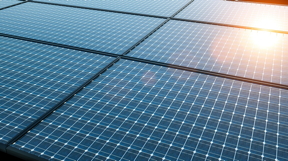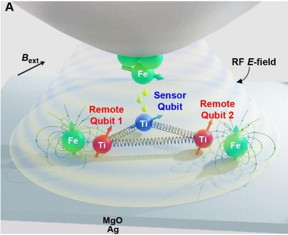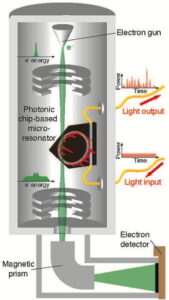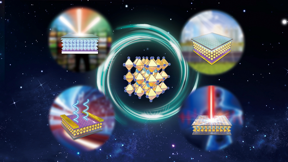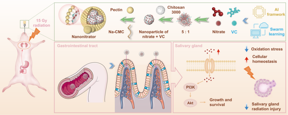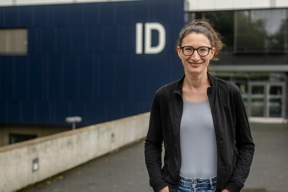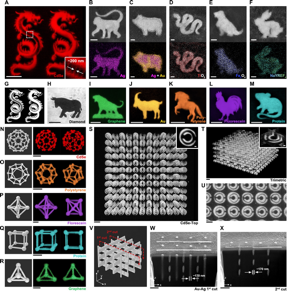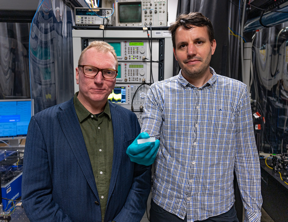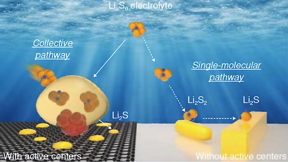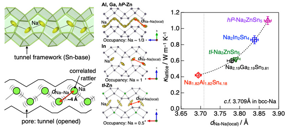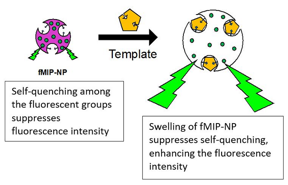Home > Press > Catalytic combo converts CO2 to solid carbon nanofibers: Tandem electrocatalytic-thermocatalytic conversion could help offset emissions of potent greenhouse gas by locking carbon away in a useful material
 |
| Scientists have devised a strategy for converting carbon dioxide (CO2) from the atmosphere into valuable carbon nanofibers. The process uses tandem electrocatalytic (blue ring) and thermocatalytic (orange ring) reactions to convert the CO2 (teal and silver molecules) plus water (purple and teal) into "fixed" carbon nanofibers (silver), producing hydrogen gas (H2, purple) as a beneficial byproduct. The carbon nanofibers could be used to strengthen building materials such as cement and lock away carbon for decades. CREDIT (Zhenhua Xie/Brookhaven National Laboratory and Columbia University; Erwei Huang/Brookhaven National Laboratory) |
Abstract:
Scientists at the U.S. Department of Energy’s (DOE) Brookhaven National Laboratory and Columbia University have developed a way to convert carbon dioxide (CO2), a potent greenhouse gas, into carbon nanofibers, materials with a wide range of unique properties and many potential long-term uses. Their strategy uses tandem electrochemical and thermochemical reactions run at relatively low temperatures and ambient pressure. As the scientists describe in the journal Nature Catalysis, this approach could successfully lock carbon away in a useful solid form to offset or even achieve negative carbon emissions.
Catalytic combo converts CO2 to solid carbon nanofibers: Tandem electrocatalytic-thermocatalytic conversion could help offset emissions of potent greenhouse gas by locking carbon away in a useful material
Upton, NY | Posted on January 12th, 2024“You can put the carbon nanofibers into cement to strengthen the cement,” said Jingguang Chen, a professor of chemical engineering at Columbia with a joint appointment at Brookhaven Lab who led the research. “That would lock the carbon away in concrete for at least 50 years, potentially longer. By then, the world should be shifted to primarily renewable energy sources that don’t emit carbon.”
As a bonus, the process also produces hydrogen gas (H2), a promising alternative fuel that, when used, creates zero emissions.
Capturing or converting carbon
The idea of capturing CO2 or converting it to other materials to combat climate change is not new. But simply storing CO2 gas can lead to leaks. And many CO2 conversions produce carbon-based chemicals or fuels that are used right away, which releases CO2 right back into the atmosphere.
“The novelty of this work is that we are trying to convert CO2 into something that is value-added but in a solid, useful form,” Chen said.
Such solid carbon materials—including carbon nanotubes and nanofibers with dimensions measuring billionths of a meter—have many appealing properties, including strength and thermal and electrical conductivity. But it’s no simple matter to extract carbon from carbon dioxide and get it to assemble into these fine-scale structures. One direct, heat-driven process requires temperatures in excess of 1,000 degrees Celsius.
“It’s very unrealistic for large-scale CO2 mitigation,” Chen said. “In contrast, we found a process that can occur at about 400 degrees Celsius, which is a much more practical, industrially achievable temperature.”
The tandem two-step
The trick was to break the reaction into stages and to use two different types of catalysts—materials that make it easier for molecules to come together and react.
“If you decouple the reaction into several sub-reaction steps you can consider using different kinds of energy input and catalysts to make each part of the reaction work,” said Brookhaven Lab and Columbia research scientist Zhenhua Xie, lead author on the paper.
The scientists started by realizing that carbon monoxide (CO) is a much better starting material than CO2 for making carbon nanofibers (CNF). Then they backtracked to find the most efficient way to generate CO from CO2.
Earlier work from their group steered them to use a commercially available electrocatalyst made of palladium supported on carbon. Electrocatalysts drive chemical reactions using an electric current. In the presence of flowing electrons and protons, the catalyst splits both CO2 and water (H2O) into CO and H2.
For the second step, the scientists turned to a heat-activated thermocatalyst made of an iron-cobalt alloy. It operates at temperatures around 400 degrees Celsius, significantly milder than a direct CO2-to-CNF conversion would require. They also discovered that adding a bit of extra metallic cobalt greatly enhances the formation of the carbon nanofibers.
“By coupling electrocatalysis and thermocatalysis, we are using this tandem process to achieve things that cannot be achieved by either process alone,” Chen said.
Catalyst characterization
To discover the details of how these catalysts operate, the scientists conducted a wide range of experiments. These included computational modeling studies, physical and chemical characterization studies at Brookhaven Lab’s National Synchrotron Light Source II (NSLS-II)—using the Quick X-ray Absorption and Scattering (QAS) and Inner-Shell Spectroscopy (ISS) beamlines—and microscopic imaging at the Electron Microscopy facility at the Lab’s Center for Functional Nanomaterials (CFN).
On the modeling front, the scientists used “density functional theory” (DFT) calculations to analyze the atomic arrangements and other characteristics of the catalysts when interacting with the active chemical environment.
“We are looking at the structures to determine what are the stable phases of the catalyst under reaction conditions,” explained study co-author Ping Liu of Brookhaven’s Chemistry Division who led these calculations. “We are looking at active sites and how these sites are bonding with the reaction intermediates. By determining the barriers, or transition states, from one step to another, we learn exactly how the catalyst is functioning during the reaction.”
X-ray diffraction and x-ray absorption experiments at NSLS-II tracked how the catalysts change physically and chemically during the reactions. For example, synchrotron x-rays revealed how the presence of electric current transforms metallic palladium in the catalyst into palladium hydride, a metal that is key to producing both H2 and CO in the first reaction stage.
For the second stage, “We wanted to know what’s the structure of the iron-cobalt system under reaction conditions and how to optimize the iron-cobalt catalyst,” Xie said. The x-ray experiments confirmed that both an alloy of iron and cobalt plus some extra metallic cobalt are present and needed to convert CO to carbon nanofibers.
“The two work together sequentially,” said Liu, whose DFT calculations helped explain the process.
“According to our study, the cobalt-iron sites in the alloy help to break the C-O bonds of carbon monoxide. That makes atomic carbon available to serve as the source for building carbon nanofibers. Then the extra cobalt is there to facilitate the formation of the C-C bonds that link up the carbon atoms,” she explained.
Recycle-ready, carbon-negative
“Transmission electron microscopy (TEM) analysis conducted at CFN revealed the morphologies, crystal structures, and elemental distributions within the carbon nanofibers both with and without catalysts,” said CFN scientist and study co-author Sooyeon Hwang.
The images show that, as the carbon nanofibers grow, the catalyst gets pushed up and away from the surface. That makes it easy to recycle the catalytic metal, Chen said.
“We use acid to leach the metal out without destroying the carbon nanofiber so we can concentrate the metals and recycle them to be used as a catalyst again,” he said.
This ease of catalyst recycling, commercial availability of the catalysts, and relatively mild reaction conditions for the second reaction all contribute to a favorable assessment of the energy and other costs associated with the process, the researchers said.
“For practical applications, both are really important—the CO2 footprint analysis and the recyclability of the catalyst,” said Chen. “Our technical results and these other analyses show that this tandem strategy opens a door for decarbonizing CO2 into valuable solid carbon products while producing renewable H2.”
If these processes are driven by renewable energy, the results would be truly carbon-negative, opening new opportunities for CO2 mitigation.
This research was supported by the DOE Office of Science (BES). The DFT calculations were performed using computational resources at CFN and at the National Energy Research Scientific Computing Center (NERSC) at DOE’s Lawrence Berkeley National Laboratory. NSLS-II, CFN, and NERSC are DOE Office of Science user facilities.
####
About DOE/Brookhaven National Laboratory
Brookhaven National Laboratory is supported by the Office of Science of the U.S. Department of Energy. The Office of Science is the single largest supporter of basic research in the physical sciences in the United States and is working to address some of the most pressing challenges of our time. For more information, visit science.energy.gov.
Follow @BrookhavenLab on social media. Find us on Instagram, LinkedIn, Twitter, and Facebook.
For more information, please click here
Contacts:
Karen McNulty Walsh
DOE/Brookhaven National Laboratory
Office: 631-344-8350
Copyright © DOE/Brookhaven National Laboratory
If you have a comment, please Contact us.Issuers of news releases, not 7th Wave, Inc. or Nanotechnology Now, are solely responsible for the accuracy of the content.
| Related Links |
| Related News Press |
News and information
![]() Researchers develop technique to synthesize water-soluble alloy nanoclusters January 12th, 2024
Researchers develop technique to synthesize water-soluble alloy nanoclusters January 12th, 2024
![]() Rice University launches Rice Synthetic Biology Institute to improve lives January 12th, 2024
Rice University launches Rice Synthetic Biology Institute to improve lives January 12th, 2024
Laboratories
![]() Three-pronged approach discerns qualities of quantum spin liquids November 17th, 2023
Three-pronged approach discerns qualities of quantum spin liquids November 17th, 2023
![]() A non-covalent bonding experience: Scientists discover new structures for unique hybrid materials by altering their chemical bonds July 21st, 2023
A non-covalent bonding experience: Scientists discover new structures for unique hybrid materials by altering their chemical bonds July 21st, 2023
Govt.-Legislation/Regulation/Funding/Policy
![]() 'Sudden death' of quantum fluctuations defies current theories of superconductivity: Study challenges the conventional wisdom of superconducting quantum transitions January 12th, 2024
'Sudden death' of quantum fluctuations defies current theories of superconductivity: Study challenges the conventional wisdom of superconducting quantum transitions January 12th, 2024
![]() 2D material reshapes 3D electronics for AI hardware December 8th, 2023
2D material reshapes 3D electronics for AI hardware December 8th, 2023
![]() World’s first logical quantum processor: Key step toward reliable quantum computing December 8th, 2023
World’s first logical quantum processor: Key step toward reliable quantum computing December 8th, 2023
Possible Futures
![]() Focused ion beam technology: A single tool for a wide range of applications January 12th, 2024
Focused ion beam technology: A single tool for a wide range of applications January 12th, 2024
![]() 'Sudden death' of quantum fluctuations defies current theories of superconductivity: Study challenges the conventional wisdom of superconducting quantum transitions January 12th, 2024
'Sudden death' of quantum fluctuations defies current theories of superconductivity: Study challenges the conventional wisdom of superconducting quantum transitions January 12th, 2024
![]() Rice University launches Rice Synthetic Biology Institute to improve lives January 12th, 2024
Rice University launches Rice Synthetic Biology Institute to improve lives January 12th, 2024
Nanotubes/Buckyballs/Fullerenes/Nanorods/Nanostrings
![]() Tests find no free-standing nanotubes released from tire tread wear September 8th, 2023
Tests find no free-standing nanotubes released from tire tread wear September 8th, 2023
![]() Detection of bacteria and viruses with fluorescent nanotubes July 21st, 2023
Detection of bacteria and viruses with fluorescent nanotubes July 21st, 2023
Discoveries
![]() Focused ion beam technology: A single tool for a wide range of applications January 12th, 2024
Focused ion beam technology: A single tool for a wide range of applications January 12th, 2024
![]() 'Sudden death' of quantum fluctuations defies current theories of superconductivity: Study challenges the conventional wisdom of superconducting quantum transitions January 12th, 2024
'Sudden death' of quantum fluctuations defies current theories of superconductivity: Study challenges the conventional wisdom of superconducting quantum transitions January 12th, 2024
![]() Development of zinc oxide nanopagoda array photoelectrode: photoelectrochemical water-splitting hydrogen production January 12th, 2024
Development of zinc oxide nanopagoda array photoelectrode: photoelectrochemical water-splitting hydrogen production January 12th, 2024
Materials/Metamaterials/Magnetoresistance
![]() Focused ion beam technology: A single tool for a wide range of applications January 12th, 2024
Focused ion beam technology: A single tool for a wide range of applications January 12th, 2024
![]() 2D material reshapes 3D electronics for AI hardware December 8th, 2023
2D material reshapes 3D electronics for AI hardware December 8th, 2023
![]() Finding the most heat-resistant substances ever made: UVA Engineering secures DOD MURI award to advance high-temperature materials December 8th, 2023
Finding the most heat-resistant substances ever made: UVA Engineering secures DOD MURI award to advance high-temperature materials December 8th, 2023
Announcements
![]() Researchers develop technique to synthesize water-soluble alloy nanoclusters January 12th, 2024
Researchers develop technique to synthesize water-soluble alloy nanoclusters January 12th, 2024
![]() Scientists use heat to create transformations between skyrmions and antiskyrmions January 12th, 2024
Scientists use heat to create transformations between skyrmions and antiskyrmions January 12th, 2024
![]() Bridging light and electrons January 12th, 2024
Bridging light and electrons January 12th, 2024
Interviews/Book Reviews/Essays/Reports/Podcasts/Journals/White papers/Posters
![]() Focused ion beam technology: A single tool for a wide range of applications January 12th, 2024
Focused ion beam technology: A single tool for a wide range of applications January 12th, 2024
![]() 'Sudden death' of quantum fluctuations defies current theories of superconductivity: Study challenges the conventional wisdom of superconducting quantum transitions January 12th, 2024
'Sudden death' of quantum fluctuations defies current theories of superconductivity: Study challenges the conventional wisdom of superconducting quantum transitions January 12th, 2024
![]() Development of zinc oxide nanopagoda array photoelectrode: photoelectrochemical water-splitting hydrogen production January 12th, 2024
Development of zinc oxide nanopagoda array photoelectrode: photoelectrochemical water-splitting hydrogen production January 12th, 2024
Environment
![]() Billions of nanoplastics released when microwaving baby food containers: Exposure to plastic particles kills up to 75% of cultured kidney cells July 21st, 2023
Billions of nanoplastics released when microwaving baby food containers: Exposure to plastic particles kills up to 75% of cultured kidney cells July 21st, 2023
![]() A non-covalent bonding experience: Scientists discover new structures for unique hybrid materials by altering their chemical bonds July 21st, 2023
A non-covalent bonding experience: Scientists discover new structures for unique hybrid materials by altering their chemical bonds July 21st, 2023
Grants/Sponsored Research/Awards/Scholarships/Gifts/Contests/Honors/Records
![]() 'Sudden death' of quantum fluctuations defies current theories of superconductivity: Study challenges the conventional wisdom of superconducting quantum transitions January 12th, 2024
'Sudden death' of quantum fluctuations defies current theories of superconductivity: Study challenges the conventional wisdom of superconducting quantum transitions January 12th, 2024
![]() 2D material reshapes 3D electronics for AI hardware December 8th, 2023
2D material reshapes 3D electronics for AI hardware December 8th, 2023
- SEO Powered Content & PR Distribution. Get Amplified Today.
- PlatoData.Network Vertical Generative Ai. Empower Yourself. Access Here.
- PlatoAiStream. Web3 Intelligence. Knowledge Amplified. Access Here.
- PlatoESG. Carbon, CleanTech, Energy, Environment, Solar, Waste Management. Access Here.
- PlatoHealth. Biotech and Clinical Trials Intelligence. Access Here.
- Source: http://www.nanotech-now.com/news.cgi?story_id=57440
- :is
- :not
- $UP
- 000
- 1
- 10
- 12th
- 17th
- 21st
- 28
- 3d
- 3rd
- 400
- 50
- 50 Years
- 7
- 7th
- 8th
- a
- About
- accuracy
- achievable
- Achieve
- achieved
- acoustic
- active
- adding
- address
- advance
- again
- AI
- All
- Alloy
- alone
- also
- alternative
- Ambient
- an
- analyses
- analysis
- analyze
- and
- Another
- appealing
- applications
- appointment
- approach
- ARE
- around
- arrangements
- Array
- AS
- assessment
- associated
- At
- Atmosphere
- atomic
- author
- availability
- available
- award
- awarded
- away
- Baby
- back
- Bacteria
- barriers
- basic
- batteries
- BE
- Beam
- beneficial
- Berkeley
- Better
- between
- biology
- Bit
- Blue
- boasts
- Bonds
- Bonus
- both
- Break
- Building
- Building Materials
- bulletproof
- burn
- but
- by
- CAN
- cannot
- Capturing
- carbon
- carbon dioxide
- carbon emissions
- Carbon monoxide
- carbon nanotubes
- Catalyst
- catalysts
- Celsius
- cement
- Center
- CGI
- challenges
- change
- characteristics
- chemical
- chemicals
- chemistry
- chen
- click
- Climate
- Climate change
- CO
- Co-Author
- co2
- Columbia
- COM
- combat
- come
- comment
- commercial
- commercially
- commitment
- compatible
- computational
- computing
- concentrate
- concrete
- Condensed matter
- conditions
- conducted
- conductivity
- CONFIRMED
- Consider
- Containers
- content
- contrast
- contribute
- conventional
- Conversion
- conversions
- convert
- converting
- Cost
- Costs
- could
- create
- creates
- credit
- Crystal
- Current
- Cut
- dance
- Death
- decades
- December
- Decline
- del
- demonstrate
- Department
- Department of Energy
- describe
- details
- Determine
- determining
- develop
- developed
- developing
- Development
- Devices
- different
- dimensions
- direct
- discover
- discovered
- distributions
- Division
- DoD
- DOE
- doesn
- Dont
- Door
- dramatically
- drive
- driven
- during
- dynamics
- each
- ease
- easier
- easy
- efficient
- either
- Electric
- Electronic
- Electronics
- electrons
- Emissions
- end
- energy
- Engineering
- Engines
- Enhances
- Environment
- Ether (ETH)
- Even
- EVER
- exactly
- example
- excess
- experience
- experiments
- Explain
- explained
- Exposure
- extra
- extract
- fabricating
- facilitate
- facilities
- Facility
- favorable
- films
- Find
- First
- fixed
- flexible
- Flowing
- fluctuations
- food
- Footprint
- For
- form
- formation
- found
- Foundation
- from
- front
- Fuel
- fuels
- functional
- functioning
- futuristic
- GAS
- generate
- get
- gif
- Graphene
- greater
- greatly
- greenhouse gas
- Group
- Grow
- Harvesting
- Have
- he
- help
- helped
- High
- How
- How To
- http
- HTTPS
- Hybrid
- hydrogen
- idea
- if
- ii
- images
- Imaging
- improve
- in
- Inc.
- included
- Including
- inexpensive
- information
- input
- Institute
- interacting
- into
- ISS
- IT
- ITS
- January
- joint
- journal
- jpg
- July
- just
- Key
- kidney
- Kills
- Know
- lab
- laboratory
- large-scale
- largest
- laser
- lasers
- launches
- lawrence
- lead
- Leaks
- LEARN
- least
- Led
- lenses
- Life
- light
- LINK
- links
- lock
- logical
- Long
- long-term
- longer
- looking
- Low
- made
- make
- MAKES
- Making
- many
- March
- material
- materials
- Matter
- measuring
- mechanism
- Media
- metal
- Metals
- methane
- method
- Microscopy
- mild
- milder
- millions
- mitigation
- modeling
- more
- most
- much
- Nanomaterials
- nanotechnology
- National
- Natural
- Natural Gas
- Nature
- needed
- negative
- net
- New
- newly
- news
- nexus
- no
- Noble
- novel
- novelty
- November
- now
- nuclear
- NY
- occur
- of
- Office
- offset
- on
- ONE
- opened
- opening
- opens
- operate
- operates
- opportunities
- Optimize
- or
- Orange
- Other
- our
- out
- palladium
- Paper
- part
- pathway
- Paul
- performance
- performed
- phases
- PHP
- physical
- Physical Sciences
- Physically
- Physics
- ping
- plastic
- plato
- Plato Data Intelligence
- PlatoData
- please
- plus
- Pollution
- Post
- posted
- potent
- potential
- potentially
- power
- Practical
- Practical Applications
- presence
- present
- press
- Press Release
- pressing
- pressure
- primarily
- process
- processes
- Processor
- produce
- produces
- producing
- Products
- Professor
- promising
- properties
- propose
- proposed
- protons
- pushed
- put
- qualities
- Quantum
- quantum technology
- Quick
- range
- rapid
- React
- reaction
- reactions
- realizing
- really
- recycling
- relatively
- release
- released
- Releases
- reliable
- remove
- Renewable
- renewable energy
- Renowned
- require
- requires
- research
- researchers
- Resources
- responsible
- Results
- return
- reveal
- Revealed
- Rice
- right
- Ring
- Rival
- Room
- Run
- s
- Said
- Save
- Science
- SCIENCES
- scientific
- Scientist
- scientists
- Search
- Second
- Secures
- sensor
- sensors
- September
- serve
- setup
- several
- Share
- she
- shifted
- should
- show
- significantly
- Silver
- Simple
- simply
- single
- Sites
- SIX
- small
- So
- Social
- social media
- solely
- solid
- some
- something
- Source
- Sources
- Spectroscopy
- speed
- Spin
- Splits
- stable
- Stage
- stages
- start
- started
- Starting
- States
- steered
- Step
- Steps
- storage
- Strategy
- strength
- Strengthen
- strong
- structure
- structures
- studies
- Study
- submit
- Successfully
- such
- sudden
- suitable
- Superconductivity
- Supported
- supporter
- Surface
- synthesize
- synthetic
- system
- Systems
- T
- Tandem
- TEAL
- Technical
- technique
- Technology
- than
- that
- The
- The Source
- the world
- their
- Them
- then
- There.
- thermal
- These
- they
- things
- this
- time
- times
- tire
- to
- together
- tool
- toward
- transformations
- transforms
- transition
- tread
- truly
- trying
- Turned
- two
- types
- u.s.
- Ultra
- under
- unique
- United
- United States
- university
- unknown
- us
- use
- used
- User
- uses
- using
- Valuable
- very
- viruses
- Visit
- wanted
- was
- Water
- Wave
- Way..
- we
- were
- What
- when
- which
- while
- WHO
- whose
- wide
- Wide range
- will
- wisdom
- with
- within
- without
- Work
- work together
- working
- world
- would
- x-ray
- Yahoo
- years
- Yield
- you
- zephyrnet
- zero










